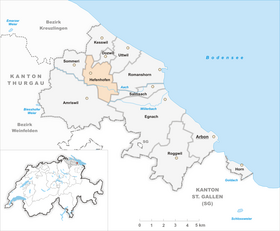Yeast furnace
| Yeast furnace | |
|---|---|
| State : |
|
| Canton : |
|
| District : | Arbon |
| BFS no. : | 4416 |
| Postal code : | 8580 |
| Coordinates : | 740 173 / 269 794 |
| Height : | 451 m above sea level M. |
| Height range : | 414-470 m above sea level M. |
| Area : | 6.08 km² |
| Residents: | 1200 (December 31, 2018) |
| Population density : | 197 inhabitants per km² |
| Website: | www.hefenhofen.ch |
| Location of the municipality | |
Hefenhofen is a municipality and a town in the district of Arbon of the Swiss canton Thurgau .
Until 2002 Hefenhofen was a unified community .
geography
The municipality located north of Amriswil comprises the 11 hamlets of Hefenhofen, Brüschwil, Hamisfeld , Auenhofen, Chappehuse, Chatzerüti, Sonnenberg, Chressibuech, Hatswil, Tohueb and Moos. Niederaach belonged to Hefenhofen from 1816 to 1936. Hefenhofen borders the communities Sommeri , Kesswil , Dozwil , Uttwil , Romanshorn , Salmsach and Amriswil.
history
Hefenhofen was first mentioned in a document in 817. Hefenhofen was a äbtisch-santa-Gallic fiefs and to the 17th century part of the rule Hagenwil ( opening 1467). In 1600 the Lower Court of Hefenhofen was formed, which included Hefenhofen, Auenhofen, Hatswil, Moos and Tonhub. In 1644 the lords of Bernhausen divided the rule, then followed several changes of ownership until 1798. Before 1798, Kressibuch was a so-called high court and directly subordinated to the federal governor in Thurgau . Hefenhofen, which has been Protestant since the Reformation , has always belonged to Sommeri in the church. In 1870 the administrations of the spatially identical local and municipal community Hefenhofen were merged to form a single community Hefenhofen.
In the 19th century, agriculture and fruit growing were predominant in Hefenhofen, and there was also a weaving mill. Towards the end of the 19th century the transition to cattle and dairy farming took place. Around 1900 Hefenhofen had several embroidery companies and a silk knitting factory . In addition to the Stutz construction business, which was founded in 1877 and had around 260 employees in 2003, and the Hatswil mill, other businesses were only settled after 1950. The waste incineration plant in the Oberthurgau region, opened in 1975, closed its doors in 1996. Today, in addition to commercial buildings, numerous single and multi-family houses characterize the rural area Community.
coat of arms
Blazon : A crowned yellow bear head in black .
The bear's head and the colors symbolize the previous close relationships between Hefenhofen and the St. Gallen monastery . The crown of the bear expresses that the Emperor Ludwig the Pious issued the certificate with the first mention of Hefenhofen.
population
 |
| year | 1850 | 1900 | 1930 | 1941 | 1950 | 1980 | 2000 | 2010 | 2018 |
| Residents | 795 | 873 | 1060 | 926 | 913 | 711 | 1108 | 1188 | 1193 |
The hamlet of Niederaach, separated from Hefenhofen in 1936, had 79 inhabitants in 1960.
Of the total of 1,193 inhabitants in the municipality of Hefenhofen in 2018, 174 or 14.6% were foreign nationals.
economy
In 2016, Hefenhofen offered 564 jobs (converted to full-time positions). 9.4% of these were employed in agriculture and forestry, 61.3% in industry, trade and construction and 29.3% in the service sector.
Political
The council consists of 5 members, including the mayor.
"Case Hefenhofen"
In 2017, the community gained national recognition as the namesake of an animal protection scandal. In the "Hefenhofen case", a horse owner from the Brüschwil district had defied regulations and laws for years and threatened officials several times. On October 31, 2018, the Thurgau government admitted numerous errors and omissions when it presented an external investigation report.
Attractions
In Hefenhofen (Sonnenberg) you will find the house "zum Roten Öpfel". It is a half-timbered building that was built in 1811 by master carpenter Knup.
Personalities
- Ernst Ackermann (1886–1978), statistician
- Emma Coradi-Stahl (1846–1912), Swiss women's rights activist, active in business
- Robert Hunger-Bühler (* 1953), actor
- Bernhard Oberholzer (* 1985), racing cyclist
- Heinrich Ott (1780 – unknown), Lord of Hefenhofen and Moos and Mayor of Zurich
- Frank Cabrera Hernandez / Kiko (* 1991), Swiss comedian, grew up in Hefenhofen
Web links
Individual evidence
- ↑ Permanent and non-permanent resident population by year, canton, district, municipality, population type and gender (permanent resident population). In: bfs. admin.ch . Federal Statistical Office (FSO), August 31, 2019, accessed on December 22, 2019 .
- ↑ a b Thurgau in figures 2019 . On the website of the Statistical Office of the Canton of Thurgau (PDF file; 1.8 MB), accessed on April 28, 2020.
- ↑ a b Localities and their resident population. Edition 2019 . On the website of the Statistical Office of the Canton of Thurgau (Excel table; 0.1 MB), accessed on April 28, 2020.
- ↑ a b c municipal coat of arms . On the website of the State Archives of the Canton of Thurgau, accessed on December 8, 2019
- ↑ StiASG , document EE5 E15a. Online at e-chartae , accessed June 19, 2020.
-
↑ Verena Rothenbühler: Hefenhofen. In: Historical Lexicon of Switzerland .
These sections are largely based on the entry in the Historical Lexicon of Switzerland (HLS), which, according to the HLS's usage information, is under the Creative Commons license - Attribution - Share under the same conditions 4.0 International (CC BY-SA 4.0). - ↑ a b c population development of the municipalities. Canton Thurgau, 1850–2000 and resident population of the municipalities and change from the previous year. Canton of Thurgau, 1990–2018. On the website of the Statistical Office of the Canton of Thurgau (Excel tables; 0.1 MB each), accessed on April 28, 2020.
- ↑ Kulturführer der Schweiz , Zurich 1982, sv «Hefenhofen», p. 177






